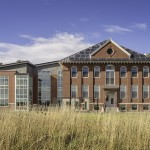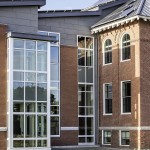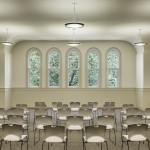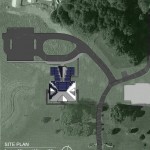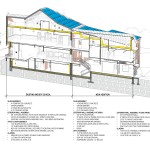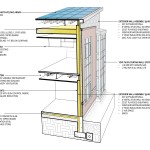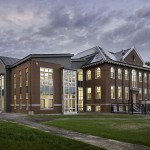Good Will-Hinckley Moody School Renovation and Addition
Project Name
The Charles E. Moody School was constructed in 1905-06 and designed by the architectural firm of William R. Miller of Lewiston, Maine, replacing an earlier structure destroyed by fire. The Moody School is a contributing structure to the “Hinckley Good Will Home Historic District,” designated a National Register of Historic Places in 1986.
Starting in 2012, Harriman was contracted to assess and design renovations for the original school and an addition to house the MeANS Charter School. The design approach is respectful of the historic building, retaining much of the original character defining features, while developing highly energy efficient alterations and classroom addition.
The building is designed to an energy usage level approximately 30% less than a conventional building. This is achieved through the use of energy efficient mechanical and lighting systems; and the building’s exterior incorporates insulation values in excess of code requirements.
During the construction phase a model update/more efficient mechanical system became available and additional measures were identified to further reduce the anticipated energy consumption. The Owner chose to retain the full planned PV production level of approximately 90,000 kWh to ensure achieving net-zero and most probably achieve net-positive. The anticipated annual PV production overage of 6,000 to 9,500 kWh will offset the energy usage of the adjacent greenhouses.
Efficiency Maine awarded incentives for several of the installed mechanical and lighting systems.
Project Area: Total 23,350 SF- 17 Classrooms, Original building: 16,150 SF – 12 Classrooms, Addition: 7,200 SF – 5 Classrooms
Architecture or A/E Firm Name
Architect
Team
Consultants
Location
Client
General Contractor
MEASURE 1: DESIGN & INNOVATION
Renovation of historic building, with minor alterations to original interior configuration. A well insulated building envelop and efficient systems contribute to a low energy demand building. Grid-tied solar PV sized to produce more energy than modeled usage offsets adjacent greenhouse demand.
MEASURE 2: REGIONAL COMMUNITY DESIGN
Restoration of unused campus asset brings vigor to the historic campus buildings overlooking the Kennebec River, and the Academy’s greenhouses.
MEASURE 3: LAND USE & SITE ECOLOGY
Using existing building and previously distrubed land resulted in minimal increase of impervious surfaces. Storm water runoff is collected in filter basin before dischage and infiltration to adjacent hay fields.
MEASURE 4: BIOCLIMATIC DESIGN
Addition sited and roof designed to maximize available surface for PV system. Addition re-oriented building’s entrance to strengthen connection to greenhouses and campus. Exterior foundation drainage and waterproofing, as well as, sub-slab drainage installed to expand occupancy to basement level: site has high water table due to high ledge elevation.
MEASURE 5: LIGHT & AIR
Daylighting is maximized in all classroom and regularly occupied spaces, operable shades installed to reduce glare. Operable windows permit fresh air on demand. LED lighting with dimming systems, daylight harvesting, and occupancy sensors all contribute to an adaptable interior experience.
MEASURE 6: WATER CYCLE
Sensor operated Low flow and ultra-low flow plumbing fixtures installed reduce water demand. Heat trace on hot water piping reduces water waste at remote fixtures.
MEASURE 7: ENERGY FLOWS & ENERGY FUTURE
Building envelope designed to perform 30% above ASHRAE 90.1, 2009, systems designed to be highly energy efficient. 87kW roof mounted solar PV system sized to permit future expansion.
MEASURE 8: MATERIALS & CONSTRUCTION
Over 70% of the project total area is renovation of an existing building. Existing building’s envelope and framing were retained and largely unaltered. Low VOC materials utilized.
MEASURE 9: LONG TERM FLEXIBILITY AND ADAPTABILITY
Design retains original classroom layout. Long life cycle, low maintenance building materials utilized.
MEASURE 10: COLLECTIVE WISDOM & FEEDBACK LOOPS
PV Dashboard displays energy production and carbon offset in the Multi-Purpose room permiting students to engage the building system daily. Staff trained in building systems and Net-Positive goals.

